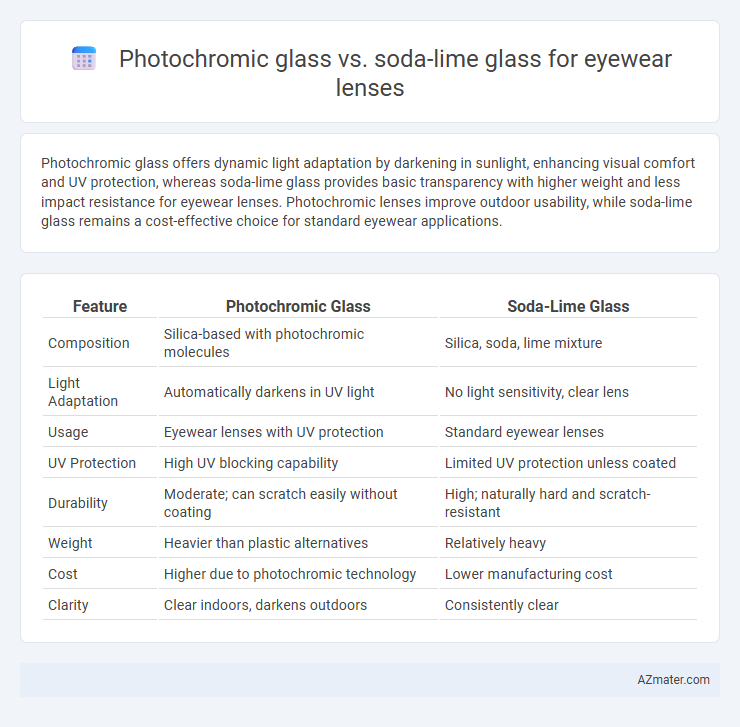Photochromic glass offers dynamic light adaptation by darkening in sunlight, enhancing visual comfort and UV protection, whereas soda-lime glass provides basic transparency with higher weight and less impact resistance for eyewear lenses. Photochromic lenses improve outdoor usability, while soda-lime glass remains a cost-effective choice for standard eyewear applications.
Table of Comparison
| Feature | Photochromic Glass | Soda-Lime Glass |
|---|---|---|
| Composition | Silica-based with photochromic molecules | Silica, soda, lime mixture |
| Light Adaptation | Automatically darkens in UV light | No light sensitivity, clear lens |
| Usage | Eyewear lenses with UV protection | Standard eyewear lenses |
| UV Protection | High UV blocking capability | Limited UV protection unless coated |
| Durability | Moderate; can scratch easily without coating | High; naturally hard and scratch-resistant |
| Weight | Heavier than plastic alternatives | Relatively heavy |
| Cost | Higher due to photochromic technology | Lower manufacturing cost |
| Clarity | Clear indoors, darkens outdoors | Consistently clear |
Introduction to Eyewear Lens Materials
Photochromic glass and soda-lime glass are two primary materials used in eyewear lenses, each offering distinct benefits for vision correction and comfort. Photochromic glass contains light-sensitive molecules that darken when exposed to UV light, providing adaptive tinting ideal for variable lighting conditions. Soda-lime glass, known for its durability and affordability, serves as a traditional lens material with high optical clarity but lacks the reactive properties of photochromic lenses.
What is Photochromic Glass?
Photochromic glass is a type of eyewear lens material that darkens automatically when exposed to ultraviolet (UV) light, providing adaptive protection against bright sunlight and reducing glare. Unlike soda-lime glass, which is a common, non-reactive material primarily used for standard lenses, photochromic glass incorporates special molecules that undergo a chemical reaction triggered by UV radiation. This dynamic feature enhances comfort and visual clarity, making photochromic glass ideal for outdoor use and variable lighting conditions.
Understanding Soda-lime Glass
Soda-lime glass, widely used in eyewear lenses, consists mainly of silica, sodium oxide, and calcium oxide, offering durability and cost-effectiveness. Its optical clarity and scratch resistance make it ideal for everyday eyewear, though it lacks the adaptive tinting properties of photochromic glass. Understanding these material properties helps consumers choose lenses that balance affordability with performance for their specific vision needs.
Light Adaptation: Photochromic vs Soda-lime Lenses
Photochromic glass lenses dynamically adjust their tint in response to ultraviolet (UV) light, providing enhanced light adaptation by darkening outdoors and clearing indoors, which reduces glare and eye strain. Soda-lime glass lenses lack this adaptive feature, maintaining a fixed transparency that can cause discomfort in varying light conditions. The photochromic technology in eyewear significantly improves visual comfort and protection compared to traditional soda-lime glass lenses.
UV Protection Capabilities
Photochromic glass offers superior UV protection by blocking 100% of harmful ultraviolet rays, making it an ideal choice for eyewear lenses designed for outdoor use. Soda-lime glass lenses provide basic UV protection but are less effective in filtering the full spectrum of UV radiation compared to photochromic lenses. The advanced UV-blocking properties of photochromic glass help prevent eye conditions such as cataracts and photokeratitis, enhancing overall eye safety.
Durability and Scratch Resistance
Photochromic glass lenses, typically made from high-quality materials like polycarbonate or trivex, offer superior scratch resistance and enhanced durability compared to conventional soda-lime glass lenses, which are more prone to chipping and scratching due to their brittleness. Soda-lime glass, while providing excellent optical clarity, lacks the advanced protective coatings found in photochromic lenses, making it less resilient in everyday wear situations. The integration of scratch-resistant coatings and impact-resistant properties in photochromic lenses makes them a preferred choice for durable and long-lasting eyewear.
Weight and Comfort Comparison
Photochromic glass lenses typically weigh more than soda-lime glass lenses due to the additional photochromic coating technology integrated for light adjustment. Soda-lime glass lenses are denser, often resulting in heavier eyewear, which can reduce overall comfort during extended wear. Photochromic lenses, often made with lightweight plastic substrates, provide better comfort by balancing light sensitivity with reduced weight compared to traditional soda-lime glass eyewear lenses.
Cost Considerations
Photochromic glass lenses typically incur higher costs due to advanced technology allowing lenses to darken automatically in response to UV light, enhancing user comfort and eye protection. Soda-lime glass lenses remain a more budget-friendly option with straightforward manufacturing processes but lack adaptive light-filtering capabilities. Consumers must weigh initial expenditure against long-term benefits like convenience and UV protection when choosing between these lens types.
Aesthetic Differences
Photochromic glass lenses offer dynamic tint changes that enhance visual comfort and aesthetic appeal by adapting to varying light conditions, providing a sleek, modern look that shifts from clear indoors to dark outdoors. Soda-lime glass lenses maintain a consistent transparency, delivering a classic and timeless appearance but lacking the transformative visual effect of photochromic technology. The choice between these materials significantly influences the eyewear's style and user experience, with photochromic glass appealing to those seeking functional elegance and soda-lime glass favored for simplicity and tradition.
Choosing the Right Lens: Key Takeaways
Photochromic glass lenses adapt automatically to changing light conditions by darkening in sunlight and clearing indoors, offering convenience and UV protection, whereas soda-lime glass lenses provide high optical clarity and scratch resistance but lack light-responsive properties. Selecting photochromic lenses benefits those seeking versatile eyewear for varied environments, while soda-lime glass is ideal for users prioritizing durability and consistent vision quality. Consider lifestyle factors, light exposure frequency, and safety needs to choose the optimal lens material for enhanced visual comfort and performance.

Infographic: Photochromic glass vs Soda-lime glass for Eyewear lens
 azmater.com
azmater.com